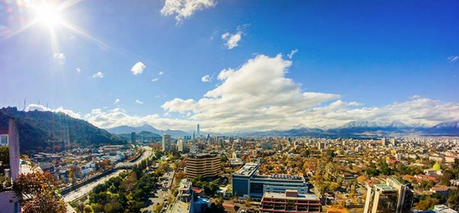
Santiago Skyline
When people think of Chile, what comes to mind are usually the breathtaking views of Atacama, treacherous hikes through Patagonia, and the stunning beaches along the coast. I’m not saying these three extremes are anything short of amazing, or else I’d be lying. However, Santiago, a metropolitan city of more than 6 million people that sits in the center of these marvels, is an amazing city itself and here are five reasons why. My name is Nick, and I’m a student who’s been here in Santiago for the last year plus, while taking some time off school.
1. La Vega Market
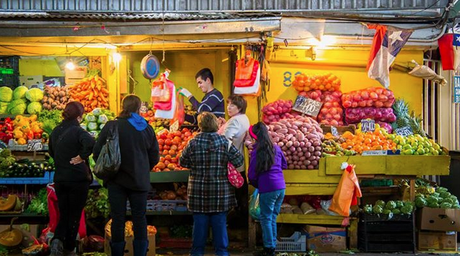
One of the Hundreds of Vendors at La Vega in the Evening
From recent memory, the last 4 clementines I’ve eaten from different regions around the world were in the California, Brazil, Argentina, and here in Chile. What’s the commonality? They all had a Chile sticker on them.
After visiting the top market in Spanish-speaking Latin America according to various sources including The Daily Meal and National Geographic, it was obvious why Chile’s produce is so prevalent and why La Vega is so highly-viewed.
First, the selection of produce is absolutely immense to say the least, but the value is what is truly amazing. You can easily find a kilo of fresh apples or grapes for 500 Chilean Pesos ($1 USD), a third of the price at any local supermarket. It can take anywhere from 20 minutes to an hour to roam around.
However, it’s not just the produce that sets La Vega apart. The restaurants in La Vega are great value as well, serving local chilean cuisine, as well as dishes from Peru, Colombia, and more. The plates are almost always under 4000 Chilean pesos (CLP), or ~8 USD.
My favorite parts of La Vega can be seen in the map below. Point 1 is the family that’s known to have the best fruit, Point 2 is where you can find fresh Ceviche plates for 2.5k CLP each, and Point 3 has palta (avocado) that takes the term buttery pear to a whole ‘nother level.
However, the hustle and madness of the market can get a bit crazy especially on Saturday mornings. For a bit tamer shopping experience you can try Mercado de Abastos Tirso del Molina right in front of La Vega, also on the map. The produce prices are similar, and on the second floor there’s about 20 restaurants serving the same types of food. My personal favorite is a Chilean/Colombian restaurant that overlooks the bridge (the bridge is point number 4).
If seafood is more your style, across the river you’ll find Mercado Central, a seafood market that boasts similar great value. A kilo of clams or fresh reineta (Chilean fish similar to flounder) for 1000 CLP, and some meals for under 4000 CLP.
La Vega opens at 6am daily, and closes at around 2pm on Sundays, 7pm every other day.
2. San Cristobal Hill
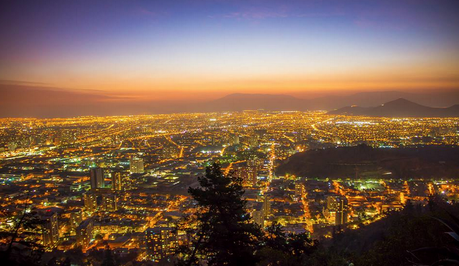
View from the West Side of Cerro San Cristobal
Although a very popular destination for foreigners, many Chileans nor ‘extranjeros’ know that ‘Cerro San Cristobal’ is the largest urban park in Spanish-speaking South America other than Parque Provincial Pereyra Iraola in Buenos Aires. With amazing views during the day or night, it is accessible both by Funicular, a cable railway that goes directly up the mountain in ~10 minutes, or by foot. It’s an easy-moderate 45 minutes hike, and on Sundays I’m usually one of the multiple cyclists trudging up. Upon the climb, you’ll have great panorama views of all of Santiago. Only on top you can truly realize the sheer size of Santiago’s population of 6.3 million where buildings extend as far as you can see in every direction. While you’re up there, soak it in with some Mote con Huesillos, a summer-time non-alcoholic drink made from peaches and wheat, cooked in cinnamon. There are multiple vendors that will run you about 1500 CLP.
While in the park you can also check out the zoo (albeit pretty bad conditions), two huge public swimming pools, a botanical garden, a Japanese Garden, and a child’s play area( Plaza de Juegos Infantiles Gabriela Mistral). The main entrance to the park is at Pío Nono 450, Barrio Bellavista; Baquedano.
3. The Big 3 Bohemian Neighborhoods
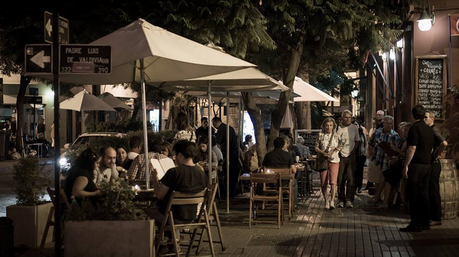
A Calm Evening in Barrio Lastarria
Santiago’s bohemian neighborhoods are awesome day and night, and are very safe relative to those of other Latin American cities. My favorites are Bellavista, LaStarria, and Barrio Italia. For their exact locations, scroll to the map on this page.
Out of the three, Bellavista is the most popular, which is where the main entrance of Cerro San Cristobal lies. There’s no shortage of restaurants, bars, cafes, and souvenir shops. My favorite dinner/snack spot is La Casa en el Aire, with a great mix of Chilean/Colombian food at very fair prices with live local music every night from Tuesdays-Saturdays. My favorite spots to grab a drink with a special someone are Etniko, who makes great non-traditional drinks and has some tasty sushi, and the Aubrey Piano Lounge which has live music Thursdays and Fridays. A cool, lesser-known place to grab coffee is a small contemporary museum/cafe called Cian that’s free to enter. It’s open from 11am to 9pm Monday to Fridays, and Saturdays noon-midnight on Saturdays. Stay updated with Patio Bellavista’s events which are listed on their website!
LaStarria, a ten minute walk from Bellavista, is located right by the Bellas Artes metro stop. It’s similar to BV with a more relaxed, European vibe right that’s not as loud at night if that’s what you’re looking for. There are a few great museums, most notably the GAM, but also the Museo de Artes Visuales and Museo Arqueológico de Santiago which all have very reasonable prices to enter. Two of my top spots off the main street are one, a flat-crust Pizza joint, Verace, and two, a Resto-bar, Bajo Llave. Bajo Llave has a nice, open patio which is awesome to sip some vino and chat on a warm summer night. Liz Caskey has a really good in-depth guide to LaStarria in her blog, EatWineBlog.
Barrio Italia, the last of the Big 3, is easiest accessible via metro at the Santa Isabel metro stop or by bus (I’ll touch on public transport below!). This neighborhood is the lesser-known and visited of the three, and has an endless amount of boutique shops featuring some really unique clothing, art, furniture, and more clothing (men, if heading there with a special lady brace yourself!). Standout spots include an Argentinian Tango resto-bar, Masa Tango, an Italian restaurant that also sells fresh pasta separately, Da Noi, and Santa Bohemia which has great drink specials. Check out Barrio Italia’s Facebook page for events going on!
4. La Piojera
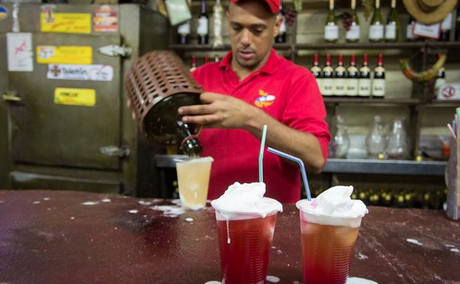
A gentleman pouring some “chicha” after serving up two terremoto death sentences
La Piojera, to be frank, is not for the faint of heart. The home of the “terremoto”, or the earthquake drink, will do to you exactly as it’s name suggests. While known to foreigners as the place where many of the longest nights in Santiago begin, it’s one of the most if not the most famous ‘picas’, or Super-Chilean restaurants in the country. Read a bit about the long history of La Piojera in this translated Wikipedia article. While not the safest place to hang out and not an ideal location to bring a date, it’s a great place to meet with a group of friends and really see a different, wilder side of Santiago.
5. Transportation
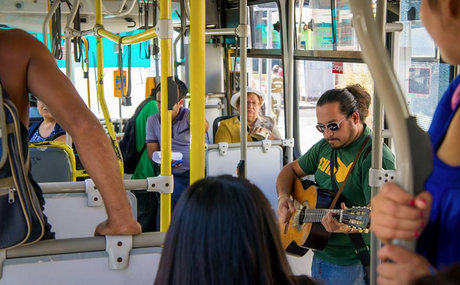
A man relieving some of the morning transit stress with his guitar
After being in metro’s everywhere from Chicago, Barcelona, Buenos Aires, Hong Kong, etc, I can honestly say Santiago’s metro has the best combination of cleanliness, easiness to navigate, and speediness that I’ve ever seen. Trains run between roughly 6.00AM and 11.30PM. The bus system is also awesome, and from using Google Maps Public Transit over the last year and visiting new destinations for my company on a weekly basis, it’s only been incorrect once or twice. If you are staying in Santiago for more than a few days, get a rechargeable ‘Bip!’ card at any subway station 1350 CLP for convenience, or alternatively you can just pay with cash/change (efectivo). Feel free to download this Metro map on your phone as well!
Aside from the public transport, Santiago was named as HostelBookers number 1 bike-friendly city in Latin America. If you go all the way from La Vega (the “Central” part of Santiago), through Providencia where the 3 neighborhoods and the Cerro are, past Constanera Center (tallest building in Latin America), all the way to to the skyscrapers of Las Condes up until Parque Bicentenario, there is a nicely paved dirt path the entire way if you just follow the river. It’s a great way to see the city and you can get some good exercise as well! I personally have not rented through Bicicleta Verde, but they’ve received a 5 star rating over 500 reviews on Tripadvisor if you’d like to just grab a bike for a few hours or a day.

